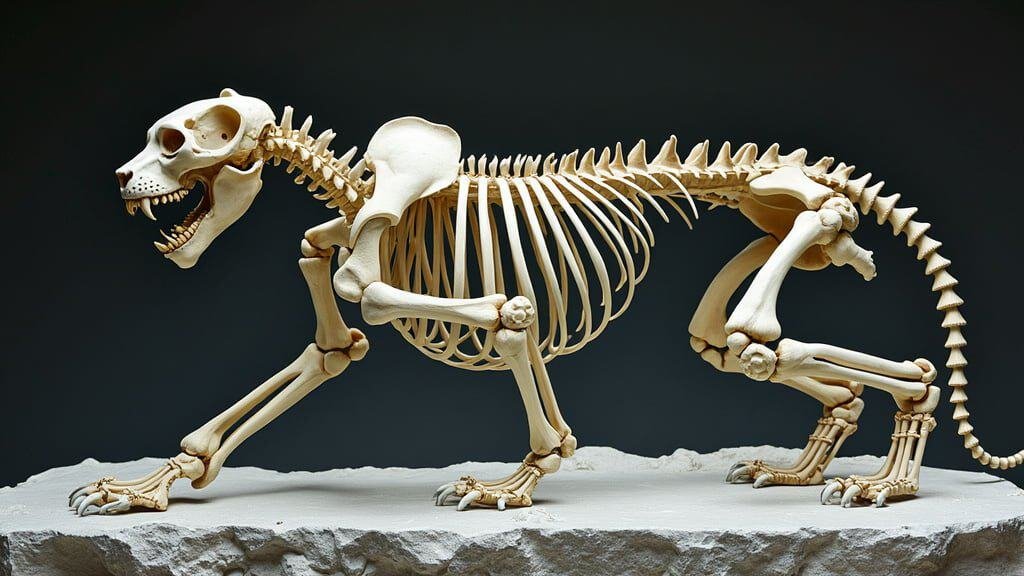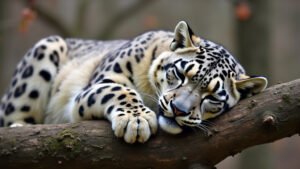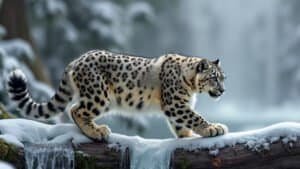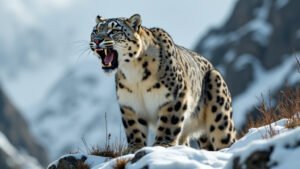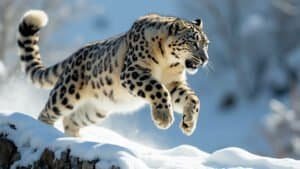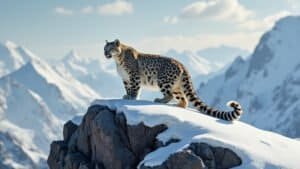Introduction
Snow leopards, with their majestic presence in the high-altitude ranges of Central Asia, exhibit several unique skeletal adaptations that set them apart from other big cats like lions, tigers, and leopards. These differences are not just superficial but are critical to their survival in some of the harshest environments on Earth
This article will delve into the distinct skeletal characteristics of snow leopards, focusing on their skull shape, vertebral column, limb proportions, and other structural features. By comparing these aspects with other big cats, we can better understand how these adaptations enable snow leopards to excel in hunting, climbing, and navigating rugged terrains
Differences In Skull Shape
The skull of the snow leopard (Panthera uncia) exhibits distinctive features that differentiate it from other big cats like lions (Panthera leo) and tigers (Panthera tigris)
These differences are closely linked to the snow leopard’s specialized lifestyle in mountainous environments, where agility and precise hunting techniques are essential for survival
Understanding these skeletal variations provides insight into the evolutionary adaptations that allow snow leopards to thrive in such unique habitats
Snow Leopard’s Rounded Skull
One of the most notable features of the snow leopard’s skull is its rounded shape. Unlike the broader, more robust skulls of lions and tigers, which are built for powerful bites and tackling large prey, the snow leopard’s skull is more compact and rounded
This shape is optimized for the snow leopard’s primary hunting strategy, which involves ambushing and swiftly taking down smaller, agile prey such as blue sheep and ibex
The rounded skull houses relatively large nasal cavities, an adaptation likely associated with the snow leopard’s need to breathe efficiently in the thin air of high altitudes, a feature less pronounced in lowland big cats
Comparison With Lion And Tiger Skulls
When comparing the snow leopard’s skull with those of lions and tigers, several differences stand out. Lions and tigers have skulls that are designed for delivering powerful, crushing bites to large prey
Their skulls are broader with stronger jaw muscles, facilitating their ability to take down larger animals such as buffalo or deer. The snow leopard, however, has a more delicate and streamlined skull. This allows for a greater range of motion in the jaw, which is crucial for gripping and holding onto prey in rugged, uneven terrains where maintaining balance is as important as strength
The snow leopard’s dental structure also reflects its different hunting needs. While both lions and tigers possess large, powerful canines suited for deep penetration, the snow leopard’s teeth are slightly smaller and more refined, suitable for gripping and suffocating its smaller prey
Additionally, the snow leopard’s carnassials, the teeth used for shearing meat, are positioned in a way that maximizes the efficiency of processing smaller, more agile prey compared to the larger, more stationary targets of lions and tigers
Impact On Feeding And Hunting
The differences in skull structure between snow leopards and other big cats have a direct impact on their feeding and hunting behaviors
The snow leopard’s relatively lighter skull, combined with its smaller, more delicate teeth, suggests that it is adapted for a hunting style that relies on speed, precision, and the element of surprise rather than sheer power. This contrasts sharply with the hunting strategies of lions and tigers, which often involve overpowering their prey with brute strength
In terms of feeding, the snow leopard’s skull is designed to handle the meat of smaller prey, which is typically consumed quickly to avoid scavengers
The more rounded shape of the skull also suggests a focus on agility and quick, decisive kills, often in challenging terrains where maintaining balance and stability is critical
Overall, the snow leopard’s skull is a key adaptation that supports its survival in the cold, mountainous regions it inhabits. Its unique features, when compared to the skulls of lions and tigers, highlight the evolutionary pressures that have shaped this elusive predator into a specialist hunter, perfectly suited to its environment
Vertebral Column And Limb Structure
The vertebral column and limb structure of the snow leopard are crucial adaptations that enable this big cat to navigate its rugged, mountainous habitat with agility and precision
These features not only provide the necessary support for climbing steep cliffs and leaping across wide gaps but also contribute to the snow leopard’s stealth and hunting prowess
Understanding these skeletal adaptations sheds light on how snow leopards differ from other big cats and why these differences are vital for their survival
Elongated Limbs For Mountainous Terrain
Snow leopards have noticeably longer limbs compared to other big cats, a trait that is especially evident in their hind legs
These elongated limbs are essential for the snow leopard’s ability to make powerful leaps, often covering distances of up to 50 feet in a single bound. This ability is crucial for traversing the rocky outcrops and ledges of their mountainous habitat, where a single misstep could be fatal
In comparison, big cats like lions and tigers, which primarily inhabit flat plains and dense forests, have more proportionate limb lengths that are designed for short bursts of speed rather than sustained leaping. The snow leopard’s longer limbs give it the advantage of reaching prey that may be hiding on higher ledges or making sudden, vertical leaps to escape predators or pursue prey
Additionally, the snow leopard’s paws are larger relative to its body size, which, combined with the elongated limbs, helps distribute its weight more evenly
This adaptation acts like a natural snowshoe, preventing the cat from sinking into deep snow, a common feature in its high-altitude environment. Other big cats do not exhibit this adaptation to the same degree, as they do not typically encounter such extreme terrain
Robust Vertebrae For Flexibility And Strength
The snow leopard’s vertebral column is another distinctive feature that sets it apart from other big cats. Snow leopards have a more flexible spine, allowing them to twist and turn their bodies with exceptional agility
This flexibility is crucial for maintaining balance on narrow ledges and during high-speed chases on uneven ground. The vertebrae themselves are robust and well-spaced, providing both the strength and flexibility needed to support the leopard’s unique mode of movement
In comparison, the vertebral columns of lions and tigers, while also strong, are less flexible. These big cats do not require the same degree of spinal flexibility because their hunting strategies often involve straight-line sprints rather than the complex maneuvers needed in the snow leopard’s mountainous habitat
The snow leopard’s vertebrae, therefore, are specifically adapted to its need for both power and agility in a three-dimensional environment
Comparison With Other Big Cats
The limb and vertebral differences between snow leopards and other big cats reflect the varying demands of their respective environments. While lions and tigers are built for power and speed on flat or gently rolling terrain, snow leopards are built for navigating vertical landscapes
The combination of elongated limbs and a flexible vertebral column allows snow leopards to excel in activities that other big cats would find challenging, such as climbing steep cliffs or leaping between narrow rock faces
Moreover, these adaptations make the snow leopard a master of stealth. The ability to move silently and with great agility across rocky and snowy landscapes is a direct result of its specialized skeletal structure
In contrast, the bulkier builds of lions and tigers, while advantageous for overpowering large prey, are less suited to the stealthy, precise movements required in the snow leopard’s environment
In conclusion, the vertebral column and limb structure of the snow leopard are key adaptations that have evolved to meet the challenges of its harsh, mountainous habitat
These features, when compared to other big cats, highlight the unique evolutionary path that snow leopards have taken, allowing them to thrive in one of the most challenging environments on Earth
Tail And Pelvic Structure
The tail and pelvic structure of the snow leopard are critical components of its skeletal system, providing balance, stability, and power. These adaptations are especially important for a species that inhabits steep, rocky terrains and needs to maintain precision in its movements
The snow leopard’s tail and pelvis distinguish it from other big cats, offering unique advantages that are essential for survival in its high-altitude environment
Adaptations For Balance And Stability
The snow leopard’s tail is one of its most distinctive features, often measuring up to 36 inches in length, which is almost as long as its body. This tail is not only long but also thick and muscular, with a dense covering of fur
The tail serves as a counterbalance when the snow leopard navigates treacherous cliffs and ledges. As the snow leopard leaps from rock to rock or sprints after prey on uneven ground, the tail helps maintain its balance by acting as a stabilizer, ensuring that the cat does not lose its footing
In comparison, the tails of other big cats like lions and tigers are shorter and less muscular, as these animals do not require the same degree of balance in their relatively flat habitats
For example, a lion’s tail is primarily used for communication and to swat away insects, rather than as a balancing tool. The snow leopard’s tail, by contrast, is a vital component of its skeletal system, finely tuned to its challenging environment
Differences In Tail Length And Usage
The length and functionality of the snow leopard’s tail are directly linked to its environmental needs. The long tail not only aids in balance but also plays a role in thermoregulation
During the extreme cold of the mountainous regions, the snow leopard often wraps its tail around its body and face to retain warmth. This dual-purpose tail is a feature not shared with other big cats, whose tails are primarily used for balance and communication
In comparison, the shorter tails of lions and tigers reflect their adaptation to warmer climates, where such an additional function is unnecessary. The snow leopard’s tail is also more flexible, allowing for precise movements that aid in hunting
Whether the leopard is perched on a narrow ledge or maneuvering through a snowy landscape, its tail provides the necessary adjustments to keep its body steady and focused on the task at hand
Snow Leopard’s Pelvic Adaptations
The snow leopard’s pelvic structure is another key adaptation that supports its lifestyle in mountainous regions. The pelvis is broader and more robust than that of other big cats, providing the necessary support for its powerful hind limbs
This structure allows the snow leopard to make high jumps and deep crouches, essential for both stalking prey and navigating steep inclines
In contrast, the pelvic structure of lions and tigers is more streamlined, supporting their need for speed in short bursts rather than sustained climbing or leaping. The snow leopard’s pelvis is designed to endure the impact of jumping down from great heights and to push off powerfully when leaping up vertical surfaces
These pelvic adaptations also contribute to the snow leopard’s unique gait, which is more deliberate and controlled than the running stride of lions or tigers
This gait allows the snow leopard to move with stealth and precision, which is critical for hunting in an environment where prey is scarce and the terrain is unforgiving
Skeletal Adaptations And Hunting Techniques
The snow leopard’s skeletal adaptations are intricately linked to its hunting techniques, which are essential for survival in the harsh, mountainous terrains it inhabits
These adaptations enhance the snow leopard’s ability to stalk, ambush, and take down prey with precision and efficiency. By examining these skeletal features, we can gain a deeper understanding of how they contribute to the snow leopard’s status as a top predator in its environment
How Skeletal Features Aid In Stealth And Speed
Stealth is a critical component of the snow leopard’s hunting strategy, and its skeletal structure plays a significant role in this ability. The snow leopard’s lightweight bones, particularly in the skull and limbs, reduce the overall weight of the animal, allowing it to move silently through its rocky habitat
This lightness, combined with the flexibility of its spine and the strength of its limbs, enables the snow leopard to approach prey undetected, even in challenging terrain
The elongated limbs, which were previously discussed, also contribute to the snow leopard’s stealth. These limbs allow for a fluid, low-to-the-ground movement that minimizes noise and visual detection
The snow leopard’s padded paws, supported by a skeletal structure that can absorb shock, ensure that each step is quiet and controlled, further enhancing its ability to sneak up on prey
In contrast, other big cats like lions rely more on speed and power, making their approach less stealthy and more reliant on the element of surprise in open environments
Climbing And Leaping Abilities
The snow leopard’s exceptional climbing and leaping abilities are directly tied to its skeletal adaptations. The robust vertebrae and muscular hind limbs allow the snow leopard to leap distances of up to 50 feet, a necessary skill for crossing wide gaps between rocks or descending steep cliffs quickly
This leaping ability is not just for movement but is also a critical part of the snow leopard’s hunting technique, enabling it to pounce on prey from a distance with great force
Climbing is another area where the snow leopard excels, thanks to its powerful limbs and flexible spine. The snow leopard can scale vertical cliffs with ease, often reaching areas that are inaccessible to both prey and potential predators
This climbing ability allows the snow leopard to ambush prey from above or escape threats by ascending to high, narrow ledges. The skeletal structure, particularly the strong claws supported by robust phalanges, provides the grip needed to secure holds on rocky surfaces
Evolutionary Benefits Of These Adaptations
The evolutionary benefits of the snow leopard’s skeletal adaptations are evident in its success as a solitary hunter in a challenging environment
These adaptations have allowed the snow leopard to exploit a niche where few other predators can survive, giving it access to prey such as ibex, blue sheep, and other mountain-dwelling animals. The snow leopard’s ability to hunt in this environment, using stealth, speed, and precision, is a direct result of its specialized skeletal structure
Compared to other big cats, which have evolved for different environments, the snow leopard’s skeletal adaptations represent a unique evolutionary path
While lions and tigers have evolved for power and speed on the plains and in forests, the snow leopard has evolved for agility, balance, and stealth in the mountains. These differences underscore the importance of skeletal adaptations in the survival and success of species, particularly in extreme environments
The snow leopard’s hunting techniques, supported by its skeletal structure, are a testament to the power of evolution in shaping species to fit their ecological niches
By understanding these adaptations, we gain insight into the remarkable capabilities of the snow leopard and the evolutionary pressures that have made it one of the most specialized predators in the animal kingdom
Conclusion
The snow leopard’s skeletal structure is a testament to the remarkable adaptations required for survival in some of the world’s most challenging environments. From its rounded skull and elongated limbs to its robust vertebral column and uniquely adapted tail and pelvic structure, each feature has evolved to enhance the snow leopard’s agility, balance, and hunting prowess
These adaptations allow the snow leopard to navigate steep, rocky terrains with precision and to hunt effectively in its mountainous habitat. When compared to other big cats like lions and tigers, the snow leopard’s skeletal features highlight its unique evolutionary path, tailored to the demands of high-altitude living
Understanding these differences not only deepens our appreciation for this elusive predator but also underscores the intricate ways in which species evolve to thrive in their specific ecological niches
